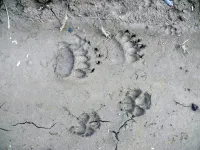Surface testing for SARS-CoV2 in hematology/oncology settings reveals negligible detection
Rutgers Cancer Institute of New Jersey research published in 'Cancer'
2021-02-18
(Press-News.org) Researchers from Rutgers Cancer Institute of New Jersey, the state's only National Cancer Institute-designated Comprehensive Cancer Center, evaluated the frequency of SARS-CoV-2, the virus that causes COVID-19, on various environmental surfaces in outpatient and inpatient hematology/oncology settings located within Rutgers Cancer Institute and Robert Wood Johnson University Hospital, an RWJBarnabas Health facility. The study revealed extremely low detection of SARS-CoV-2 on environmental surfaces across multiple outpatient and inpatient oncology areas, including an active COVID-19 floor. Andrew M. Evens, DO, MSc, FACP, associate director for clinical services and director of the Lymphoma Program at Rutgers Cancer Institute and medical director of the oncology service line at RWJBarnabas Health, is senior author of the work, which has been published in the February 18 online edition of Cancer. (doi: 10.1002/cncr.33453)
Patients harboring hematologic malignancies, which are cancers that affect the blood, bone marrow, and lymph nodes, have demonstrated a potential higher mortality rate due to the virus. While COVID-19 is transmitted person to person through respiratory droplets, it has been hypothesized that there is a potential risk of SARS-CoV-2 spreading via contact with contaminated surfaces and equipment, especially in healthcare settings, creating additional concern for patients with blood cancers.
"For patients with blood cancers who may be at higher risk of developing complications from the virus, our findings provide a layer of assurance that these patients are safe when frequenting high impact areas where they receive their cancer care," notes Dr. Evens, who is also a professor of medicine at Rutgers Robert Wood Johnson Medical School. "The results of this study help us further understand how COVID-19 is transmitted in hematology/oncology and other medical settings, and confirm that strategies like enhanced cleaning and disinfecting policies are extremely effective."
Environmental swabbing took place in two outpatient clinics including the malignant hematology and medical oncology units and infusion suites as well as inpatient areas which included the leukemia/lymphoma/CAR T-cell unit, and an inpatient unit caring for patients actively infected with COVID-19. Surfaces were sampled on Mondays, Wednesdays and Fridays from June 17, 2020 through June 29, 2020. Areas included waiting rooms, infusion areas, bathrooms, floors, elevator banks, doors, and exam rooms, computer equipment, pneumatic tubing stations, pharmacy benches, and medication rooms. Medical equipment was also swabbed from these areas including intravenous poles, chemotherapy bags, vitals monitor, telemetry stations, and linen carts.
Analysis of the 130 samples collected were separated into three categories: patient/public areas (85), staff areas (22), and medical equipment (23). In the two outpatient clinics and inpatient leukemia/lymphoma/CAR T-cell unit, no SARS-CoV-2 was detected on any swabbed surfaces. In the inpatient COVID unit, one patient/public sample was positive for detection of SARS-CoV-2 in an area where a patient with recent infection was receiving treatment.
Thus, the overall positive test rate for SARS-CoV-2 across all surfaces in the combined outpatient and inpatient hematology/oncology units was a low 0.5 percent.
The authors note study limitations including the inability to analyze the complete surface area of the varied locations, which may have reduced sensitivity. In addition, researchers did not attempt to culture SARS-CoV-2 from the one positive sample; it is unknown if it contained live virus. Continued studies are needed to monitor rates of virus transmission and the environmental factors involved in the propagation of the SARS-CoV-2 infection.
INFORMATION:
ELSE PRESS RELEASES FROM THIS DATE:
2021-02-18
Annapolis, MD; February 17, 2021--When the invasive spotted lanternfly arrived in the United States in 2014, it was immediately recognized for the threat it posed to native plants and crops. A community of researchers and experts in science, agriculture, and government sprang into action to respond, improving our chances for containing the pest and curbing its potential for damage.
While the effort continues, a new collection curated by the Entomological Society of America's family of journals showcases the growing body of research that is helping us understand the spotted lanternfly's biology and how to contain it. The collection features 25 articles published ...
2021-02-18
When there is a choice, wolves in Mongolia prefer to feed on wild animals rather than grazing livestock. This is the discovery by a research team from the University of Göttingen and the Senckenberg Museum Görlitz. Previous studies had shown that the diet of wolves in inland Central Asia consists mainly of grazing livestock, which could lead to increasing conflict between nomadic livestock herders and wild predatory animals like wolves. The study has been published in the journal Mammalian Biology.
Around three million people live in Mongolia, making it the most sparsely populated country in the world. In addition, there are more than 40 million grazing animals. These animals are not just a source of food but also the ...
2021-02-18
By 2030 only EV's will be in production, meaning manufacturers are racing to create a high-energy battery that's affordable and charges efficiently, but conventional battery cathodes cannot reach the targets of 500Wh/Kg
Lithium-excess cathodes offer the ability to reach 500Wh/Kg but unlocking their full capacity means understanding how they can store charge at high voltages.
A new X-ray study lead by WMG, University of Warwick has resolved how the metals and oxygen facilitate the charge storage at high voltages.
High energy storage batteries for EVs need high capacity battery cathodes. New lithium-excess magnesium-rich cathodes are expected to replace existing nickel-rich cathodes but understanding how the magnesium and oxygen accommodate charge storage at high ...
2021-02-18
As investors set their sights on the mineral resources of the deep seabed, the International Seabed Authority (ISA) is developing regulations that will govern their future exploration and possible exploitation. A new IASS Policy Brief, published in cooperation with the Federal Environment Agency (UBA), presents three recommendations to ensure that future deep seabed mining would be to the common benefit all humankind, as required by international law.
The ecosystems of the deep ocean are complex and provide a wide range of benefits to humankind. Oceans soak up carbon dioxide and act as a natural buffer to global warming in addition to regulating the climate and serving as an important ...
2021-02-18
CHAMPAIGN, Ill. -- Researchers report that 4-6-year-old children who walk further than their peers during a timed test - a method used to estimate cardiorespiratory health - also do better on cognitive tests and other measures of brain function. Published in the Journal of Clinical Medicine, the study suggests that the link between cardiorespiratory fitness and cognitive health is evident even earlier in life than previously appreciated.
Most studies of the link between fitness and brain health focus on adults or preadolescent or adolescent children, said doctoral student Shelby Keye, who led the new research with Naiman Khan, a professor of kinesiology and ...
2021-02-18
CHAMPAIGN, Ill. -- Workers with science, technology, engineering and math backgrounds are typically in high demand - but the demand isn't so overwhelming that a "skills gap" exists in the labor market for information technology help desk workers, one of the largest computer occupations in the U.S., says new research from a University of Illinois Urbana-Champaign expert who studies labor economics and work issues.
The incidence of prolonged hiring difficulties for STEM workers is modest, with only 11%-15% of IT help desks in the U.S. showing vacancy patterns that might be consistent with persistent hiring frictions, said Andrew Weaver, a professor ...
2021-02-18
The mechanism that keeps arterial blood pressure stable in black and white tegu lizards (Salvator merianae) even as their body temperature varies substantially is more efficient at lower than higher external temperatures, contrary to what has always been believed, and vascular regulation plays a key role in pressure adjustments, according to an article published in PLOS ONE by researchers at the Federal University of São Carlos (UFSCar) in the state of São Paulo, Brazil. The research was supported by FAPESP.
The findings pave the way for more investigation of the physiology of ectothermic animals, which rely on external environmental factors to regulate body temperature, and of novel applications for the method used in ...
2021-02-18
A new study concluding out of Lusaka, Zambia last summer has found that as many as 19% (almost 1 in 5) of recently-deceased people tested positive for COVID-19.
A new Boston University School of Public Health (BUSPH) study in Lusaka, Zambia's capital, challenges the common belief that Africa somehow "dodged" the COVID-19 pandemic.
The findings indicate that low numbers of reported infections and deaths across Africa may simply be from lack of testing, with the coronavirus taking a terrible but invisible toll on the continent.
Published in The BMJ, the study found that at least ...
2021-02-18
Neutralizing antibodies develop within two weeks of a SARS-CoV-2 infection, but their durability and intensity can vary by individual, prompting concerns about the prospects of long-lasting immunity and efficacy of COVID-19 vaccines.
In a PLOS ONE paper, published online February 11, 2021, researchers at University of California San Diego School of Medicine report that individual immune response to SARS-CoV-2, the virus that causes COVID-19, may be limited by the major histocompatibility complex or MHC, a set of variable genes that code for cell surface proteins essential for the adaptive immune system.
Specifically, ...
2021-02-18
Dreams take us to what feels like a different reality. They also happen while we're fast asleep. So, you might not expect that a person in the midst of a vivid dream would be able to perceive questions and provide answers to them. But a new study reported in the journal Current Biology on February 18 shows that, in fact, they can.
"We found that individuals in REM sleep can interact with an experimenter and engage in real-time communication," said senior author Ken Paller (@kap101) of Northwestern University. "We also showed that dreamers are capable of comprehending questions, engaging in working-memory operations, and producing answers. ...
LAST 30 PRESS RELEASES:
[Press-News.org] Surface testing for SARS-CoV2 in hematology/oncology settings reveals negligible detection
Rutgers Cancer Institute of New Jersey research published in 'Cancer'






